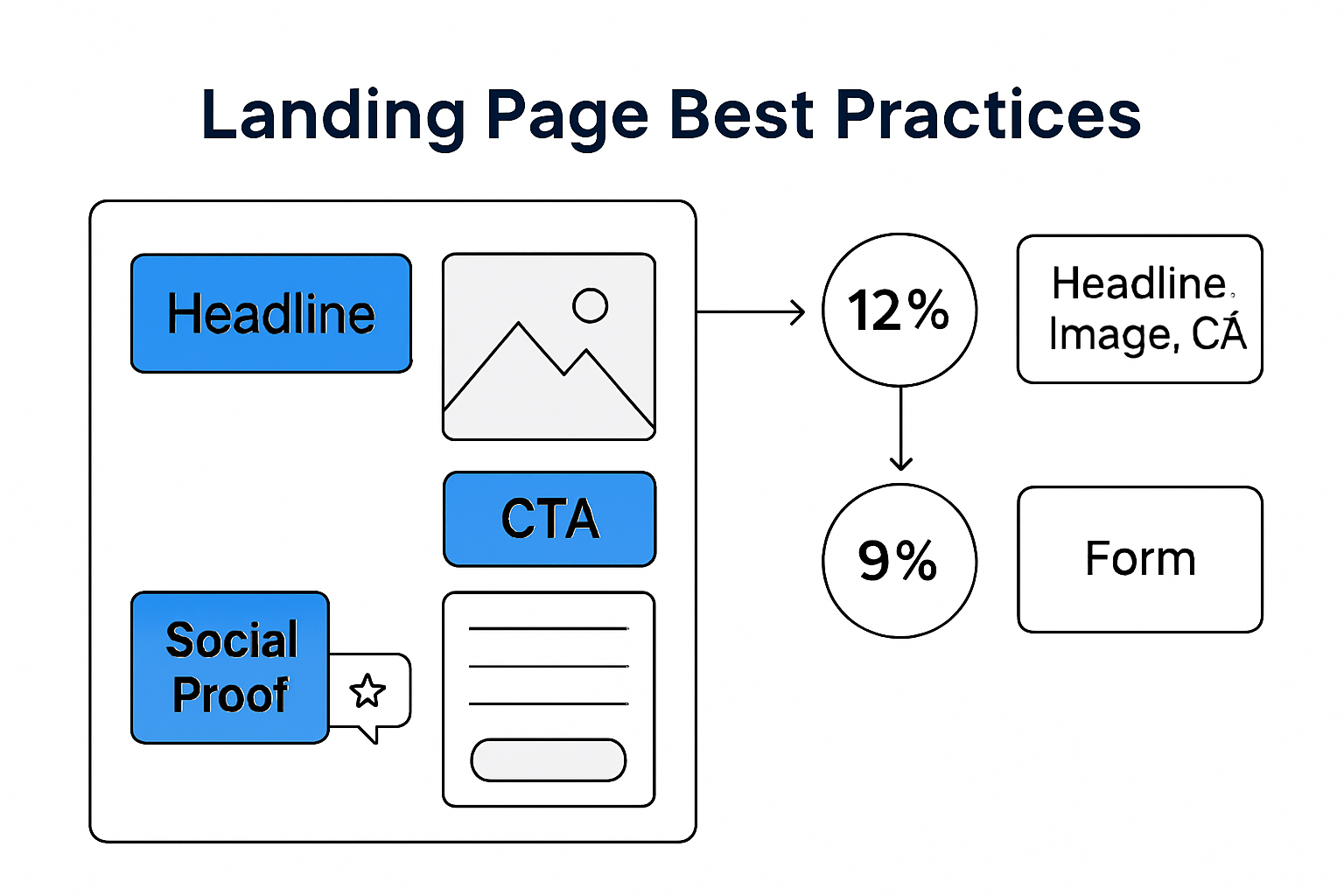Landing page optimization is shaping the way brands connect with their audience online and the race for higher conversion rates is fierce. Most people obsess over color palettes and fonts thinking that’s what delivers results. But the real difference-maker is much simpler and also surprising. Studies show that adding a compelling hero image can boost conversions by up to 65 percent which means your visuals might be driving more sales than any headline ever could. Imagine what else you might be overlooking.
Table of Contents
- Understanding The Basics Of Landing Page Optimization
- Key Elements For High-Converting Landing Pages
- Advanced Tips To Boost Landing Page Performance
- Tools And Metrics For Ongoing Optimization
Quick Summary
| Takeaway | Explanation |
| Optimize for user intention | Create landing pages that focus on specific user actions, such as sign-ups or purchases. |
| Use clear, compelling visuals | Invest in strong visual storytelling to grab attention and communicate value quickly. |
| Limit choices to reduce paralysis | Simplify options on landing pages to help users make decisions without feeling overwhelmed. |
| Leverage social proof effectively | Include testimonials and reviews to build trust and enhance credibility with potential customers. |
| Continuously test and refine | Implement A/B testing regularly to improve elements like headlines and CTAs for better conversions. |
Understanding the Basics of Landing Page Optimization
Landing page optimization represents a critical strategy for digital marketers seeking to transform website visitors into potential customers. At its core, this process involves strategically designing and refining web pages to maximize user engagement and conversion rates.
The Fundamental Purpose of Landing Pages
A landing page serves as a specialized web page designed with a single focused objective. Unlike standard website pages, landing pages are crafted to guide visitors toward a specific action, whether signing up for a newsletter, downloading a resource, or making a purchase. Research from Wikipedia highlights that effective landing pages utilize targeted content and strategic design elements to increase the likelihood of user conversion.
The scientific approach to landing page optimization reveals fascinating insights into user behavior. A study by Nim Dvir and Ruti Gafni demonstrated a critical relationship between content volume and user engagement. Surprisingly, their research indicates that excessive information can actually deter potential customers from taking desired actions. This finding underscores the importance of creating concise, purposeful landing pages that communicate value without overwhelming visitors.
Key Elements of High Converting Landing Pages
Successful landing pages share several fundamental characteristics that drive user interaction. Visual clarity stands as the first critical component. Users must immediately understand the page’s purpose and value proposition. This means implementing clean design, compelling headlines, and strategically placed call to action buttons.
Content strategy plays an equally important role. The most effective landing pages balance informative content with psychological triggers that motivate action. According to research by Jaros2aw Jankowski and colleagues, there exists a precise balance between visual intensity and user experience that maximizes conversion potential. This suggests that landing pages must be meticulously crafted to provide just the right amount of visual and informational stimulation.
Optimization Strategies for Maximum Impact
Optimizing a landing page requires a multifaceted approach. Key strategies include:
- Targeted Messaging: Develop content that speaks directly to your specific audience’s needs and pain points.
- Clear Value Proposition: Communicate the unique benefits users will receive by taking action.
- Simplified Design: Remove unnecessary elements that might distract from the primary conversion goal.
Technical considerations are equally crucial. Page load speed, mobile responsiveness, and intuitive navigation contribute significantly to user experience and conversion rates. Marketers must continuously test and refine their landing pages, using data driven insights to make incremental improvements.
Landing page optimization is not a one time task but an ongoing process of understanding user behavior, testing hypotheses, and adapting to changing digital landscapes. By focusing on user experience, clear communication, and strategic design, businesses can create landing pages that not only attract visitors but effectively convert them into valuable customers.
Key Elements for High-Converting Landing Pages
Creating a high-converting landing page requires a strategic approach that combines psychological triggers, design principles, and user-centric content. Successful landing pages are not accidental but meticulously crafted experiences designed to guide visitors toward a specific action.
Visual Storytelling and First Impressions
The visual elements of a landing page play a crucial role in capturing and maintaining user attention. Research by EyeQuant reveals that adding a compelling hero image can increase conversion rates by up to 65%. This underscores the power of visual storytelling in creating an immediate emotional connection with visitors.
Hero images should not merely be decorative but serve a strategic purpose. They must:
- Quickly communicate the core value proposition
- Evoke an emotional response
- Provide visual context for the offer
The first few seconds are critical. Visitors make split-second decisions about whether to engage or exit, making visual clarity and immediate value communication paramount.
Psychological Principles of Conversion
Understanding user psychology is key to designing effective landing pages. According to Hick’s Law, presenting too many choices can lead to decision paralysis. This principle suggests that simplifying options and creating a clear, focused path can significantly improve conversion rates.
Social proof emerges as another powerful psychological trigger. Research from BrightLocal indicates that consumers typically read at least 10 reviews before trusting a business, spending nearly 14 minutes examining customer feedback. Strategically placed testimonials, case studies, and trust signals can dramatically increase landing page credibility.
Crafting Compelling Conversion Elements
 The mechanics of conversion require precise attention to detail. Key elements include:
The mechanics of conversion require precise attention to detail. Key elements include:
- Headline: Create a bold, clear statement that immediately communicates unique value
- Call to Action (CTA): Design a prominent, contrasting button that stands out and uses action-oriented language
- Form Design: Keep form fields minimal and request only essential information
Technical considerations such as page load speed, mobile responsiveness, and intuitive navigation further support conversion potential. Every element should serve a specific purpose, eliminating potential friction points that might discourage user action.
Landing page optimization is an iterative process. Continuous testing, measuring user behavior, and making data-driven refinements ensure that your landing pages remain effective in an ever-changing digital landscape. By combining psychological insights, design principles, and user-centric content, businesses can create landing pages that not only attract attention but successfully convert visitors into customers.
To help clarify the most important conversion elements and their crucial characteristics, the following table summarizes their purpose and best practices.
| Conversion Element | Purpose | Best Practice |
| Headline | Capture attention, convey value | Be bold, clear, and immediately relevant |
| Call to Action (CTA) | Direct users to take desired action | Use strong, action words & contrasting buttons |
| Form Design | Capture user info with minimal friction | Keep fields minimal, ask only what’s necessary |
| Hero Image | Establish emotional connection & context | Use relevant, high-quality visuals |
| Social Proof | Build trust and demonstrate credibility | Show testimonials, reviews, and case studies |
| Navigation/Design Simplicity | Keep users focused and reduce distractions | Limit links, declutter, focus on primary goal |
Advanced Tips to Boost Landing Page Performance
As digital marketing continues to evolve, landing page optimization requires increasingly sophisticated strategies that go beyond basic design principles. Advanced performance enhancement demands a nuanced approach combining data analysis, psychological insights, and cutting-edge technological considerations.
Strategic Performance Optimization Techniques
Research from Gartner emphasizes the critical importance of aligning landing pages precisely with specific business objectives. This alignment goes far beyond aesthetic considerations, focusing on creating targeted experiences that directly address user needs and organizational goals.
Visual complexity plays a significant role in user engagement. Intriguing research from arXiv reveals that less visually complex landing pages correlate with higher user engagement and improved learning success. This insight suggests that marketers should prioritize clean, purposeful design over cluttered, information-heavy layouts.
Data-Driven Conversion Enhancement
A/B testing emerges as a powerful methodology for continuous landing page improvement. Scientific research published by NCBI demonstrates how systematic testing of different design elements can dramatically impact conversion rates. Marketers should approach optimization as an ongoing experiment, systematically testing variables such as:
- Headline variations
- Color schemes and visual hierarchy
- Call to action placement and wording
Advanced landing page performance requires a holistic approach that integrates technical optimization with user experience design. learn more about strategic keyword optimization to further refine your landing page strategy.
Technical performance metrics remain crucial. Page load speed, mobile responsiveness, and seamless cross device functionality are no longer optional but mandatory for high-converting landing pages. Modern users expect instantaneous, frictionless experiences that provide immediate value.
Psychological Triggers and Conversion Psychology
Understanding user psychology represents the next frontier of landing page optimization. Sophisticated marketers now incorporate advanced psychological triggers that go beyond traditional persuasion techniques. These include:
- Employing social proof through dynamic, authentic testimonials
- Creating a sense of urgency without appearing manipulative
- Designing intuitive user pathways that feel natural and unforced
Successful landing pages in 2025 will distinguish themselves by creating personalized, contextually relevant experiences that feel tailored to individual user needs. This requires leveraging advanced data analytics, machine learning, and a deep understanding of user behavior patterns.
Landing page optimization is no longer about incremental improvements but about creating transformative user experiences that seamlessly guide visitors toward meaningful actions. By combining technical excellence, psychological insights, and data-driven strategies, businesses can develop landing pages that not only attract attention but fundamentally reshape user engagement.
To clearly outline essential technical and psychological tactics for advanced optimization, the following table provides a quick reference of strategies and their targeted outcomes.
| Advanced Optimization Strategy | Focus Area | Targeted Outcome |
| A/B Testing | Data-Driven Refinement | Improved element conversion rates |
| Streamlined Visual Design | User Experience | Higher engagement, reduced bounce rate |
| Performance Metrics Monitoring | Technical | Faster load times, better user retention |
| Social Proof Implementation | Trust/Psychology | Increased credibility and conversions |
| Personalized User Experience | Contextual Relevance | Higher satisfaction, conversion uplift |
| Machine Learning Optimization | Predictive Analytics | Adaptive, real-time landing page changes |
Tools and Metrics for Ongoing Optimization
Optimizing landing pages requires a comprehensive approach that integrates sophisticated tools and precise performance metrics. Modern digital marketers must leverage advanced technologies and analytical frameworks to continuously improve their landing page effectiveness.
Performance Measurement and Analytics
Research from EAB highlights the critical importance of tracking comprehensive website performance metrics. These metrics extend beyond basic traffic numbers, providing nuanced insights into user behavior and engagement.
Key performance indicators to monitor include:
- Total daily page views
- Unique daily page views
- Traffic source breakdown (organic search, email, direct, referral, social, paid search)
Understanding these metrics allows marketers to identify high-performing channels and optimize content strategies accordingly. By analyzing these data points, businesses can make informed decisions about landing page design and user experience.
Technical Performance Optimization Tools
Google PageSpeed Tools represents a critical resource for technical performance optimization. These tools provide comprehensive analysis and recommendations for improving website speed and user experience. Key components include PageSpeed Module, PageSpeed Insights, and Chrome DevTools extension.
Technical optimization tools help marketers:
- Analyze page load times
- Identify performance bottlenecks
- Generate specific recommendations for improvement
- Understand mobile and desktop performance variations
learn more about strategic optimization techniques to enhance your landing page performance comprehensively.
Advanced Optimization Strategies
Successful landing page optimization goes beyond simple metric tracking. It requires a holistic approach that combines quantitative data with qualitative user insights. Advanced strategies include:
- Implementing continuous A/B testing
- Using heat mapping tools to understand user interaction
- Conducting user experience (UX) research
- Integrating machine learning for predictive optimization
Real-time analytics and adaptive optimization represent the future of landing page performance. By leveraging sophisticated tools and maintaining a data-driven approach, businesses can create landing pages that dynamically adjust to user preferences and behaviors.
The landscape of digital marketing continues to evolve rapidly. Marketers must remain agile, continuously learning and adapting their optimization strategies. Tools and metrics are not static endpoints but dynamic resources that require ongoing attention and sophisticated interpretation.
Ultimately, the most successful landing pages will be those that combine technical excellence, deep user understanding, and a commitment to continuous improvement. By embracing advanced tools and maintaining a rigorous approach to performance measurement, businesses can create landing pages that not only attract visitors but consistently convert them into valuable customers. 
Frequently Asked Questions
What is landing page optimization?
Landing page optimization is the process of enhancing web pages to increase user engagement and conversion rates by strategically designing and refining them for specific actions, like sign-ups or purchases.
How can I improve my landing page conversion rates?
You can improve conversion rates by using clear visuals, creating a strong value proposition, simplifying the design, reducing choices to prevent paralysis, and leveraging social proof through testimonials and reviews.
Why is visual storytelling important for landing pages?
Visual storytelling captures user attention and creates an emotional connection. A compelling hero image can significantly increase conversion rates by quickly conveying the core value proposition and engaging visitors immediately.
What are essential elements of a high-converting landing page?
Key elements include a strong headline, an effective call to action, a clean and concise form design, relevant hero images, and social proof like testimonials that enhance credibility.
Ready to Remove Barriers in Landing Page Optimization?
Are you struggling to turn engaged visitors into loyal customers despite refining your visual storytelling and CTAs? As highlighted in our insights on user intention, page clarity, and performance metrics, hidden technical issues like keyword cannibalization can quietly sabotage conversion rates. Our research-driven strategies help clarify your value, but unresolved keyword overlap can drain your landing page potential before users even arrive.
Don’t let your landing pages underperform because of overlooked SEO conflicts. Take charge today with the #1 Keyword Cannibalization Tool designed for agencies and consultants who demand real results. Find and fix bottlenecks quickly so every landing page delivers the impact you need. Visit rankaligner.com now to start eliminating keyword cannibalization and boost every page’s chances of converting in 2025. Your optimized future starts now.

